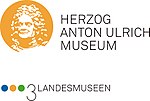Johann Heinrich Haeberlin (museum director)
Johann Heinrich Haeberlin (born May 15, 1738 in Braunschweig ; † August 23, 1808 there ) was a German councilor and museum director. He worked for more than 50 years at the ducal art and natural history cabinet, today's Herzog Anton Ulrich Museum , of which he was director from 1780 to 1806.
Life
Johann Heinrich Haeberlin was born in Braunschweig in 1738 as the son of the valet Eberhard Ernst Haeberlin. In 1758 he attended the Collegium Carolinum there and in 1771 began studying law at the University of Helmstedt . He was a canon and subsequently a senior at the St. Cyriakus monastery in Braunschweig.
Haeberlin worked at the ducal art and natural history cabinet in Braunschweig as a registrar from 1765 and as a secretary from 1777. In 1780 he was appointed court advisor and entrusted with the management of the museum, whose holdings he sought to preserve. He completed the list of items in the collection. During the reign of Duke Karl Wilhelm Ferdinand , an expansion of the collection was practically impossible because, according to Alfred Walz, he lacked the enthusiasm "for acquiring and storing objects that mainly served aesthetic satisfaction". Only individual new acquisitions from the circle of the ducal family have been documented for the period from 1780 to 1806. Haeberlin left no scientific work. He died in August 1808 at the age of 70 in Braunschweig.
Works
In 1768 Haeberlin made a colored drawing of the floor plan of the museum at the new location in the Pauline Monastery on Bohlweg , which has existed since 1765 . In the sketch he noted the positions of the essential collection departments. Haeberlin played a key role in the creation of the Braunschweiger Daktyliothek , the collection of impressions of cut jewelry or precious stones ( gems or cameos ). The completion of this Dactyliotheca Musei Brunsvicensis is noted in a note from the later museum director Johann Gottfried Hoefer on September 7, 1771: “The registrar Haeberlin has now cast all the deep-cut stones in the cabinet, as well as the glass casts from the French and other collections in plaster . "
literature
- Jochen Luckhardt : Haeberlin, Johann Heinrich. In: Horst-Rüdiger Jarck , Günter Scheel (ed.): Braunschweigisches Biographisches Lexikon - 19th and 20th centuries . Hahnsche Buchhandlung, Hannover 1996, ISBN 3-7752-5838-8 , p. 238 .
- Alfred Walz : The Age of Enlightened Absolutism (1735-1806). In: Jochen Luckhardt (Ed.): The Herzog Anton Ulrich Museum and its collections. 1578 1754 2004. Hirmer Verlag, Munich 2004, ISBN 3-7774-2295-9 .
Individual evidence
- ↑ Johanna Lessmann, Susanne König-Lein: Johann Heinrich Haeberlin, floor plan of the Ducal Museum 1765 . In: Wax work from the 16th to the 20th century . Herzog-Anton-Ulrich-Museum, Braunschweig 2002, ISBN 3-922279-53-8 , p. 17 , doi : 10.24355 / dbbs.084-201810101206-0 ( tu-braunschweig.de [PDF]).
- ^ Alfred Walz: The Age of Enlightened Absolutism (1735-1806). In: Jochen Luckhardt (Ed.): The Herzog Anton Ulrich Museum and its collections. 1578 · 1754 · 2004. Hirmer Verlag, Munich 2004, p. 157.
- ↑ Gisela Bungarten, Jochen Luckhardt (ed.): Charm of antiquity: The Brunswick dukes and the beauties of antiquity in the 18th century. Exhibition in the Herzog Anton Ulrich-Museum Braunschweig, August 21 to November 16, 2008. Petersberg 2008, p. 194 ( online PDF).
| personal data | |
|---|---|
| SURNAME | Haeberlin, Johann Heinrich |
| BRIEF DESCRIPTION | German councilor and museum director |
| DATE OF BIRTH | May 15, 1738 |
| PLACE OF BIRTH | Braunschweig |
| DATE OF DEATH | August 23, 1808 |
| Place of death | Braunschweig |

